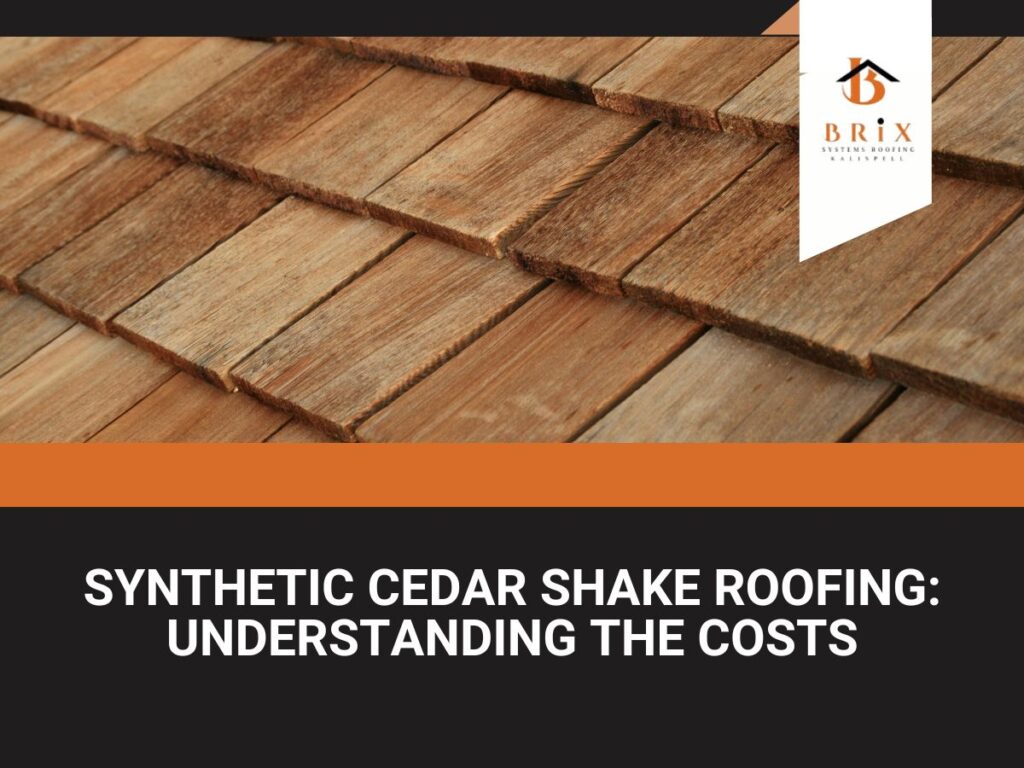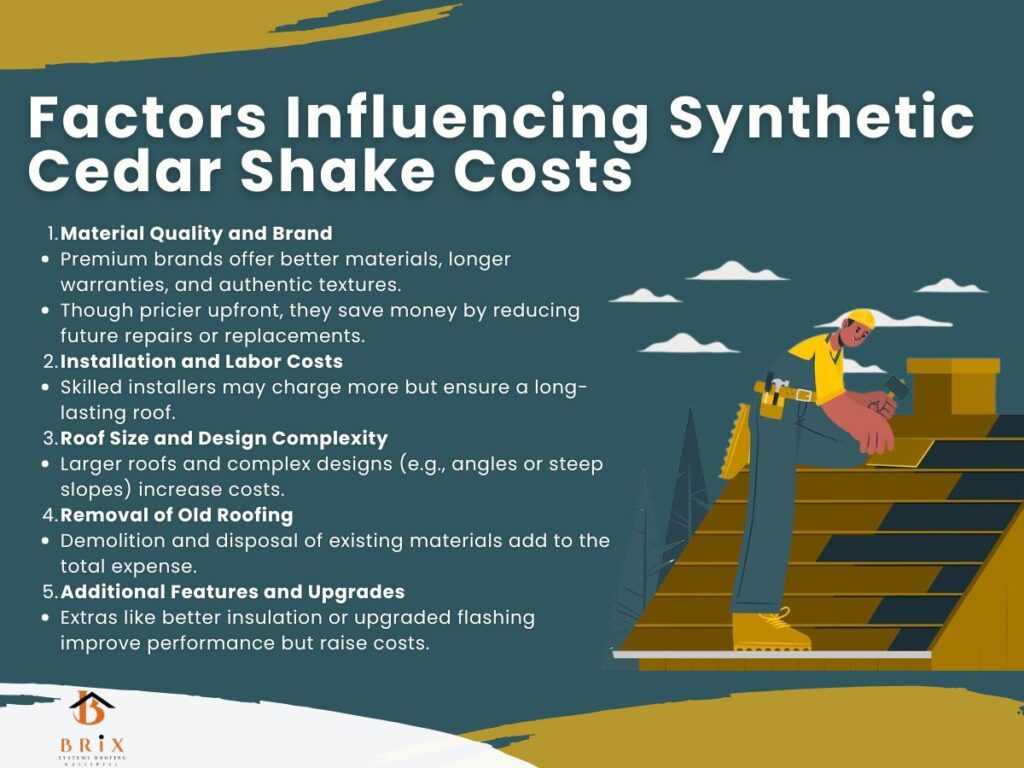
When you're thinking about re-roofing your home, synthetic cedar shake might be one of those options that sounds a bit too fancy at first, but it’s more approachable than you might think. You’re likely after that classic cedar shake charm that makes homes feel cozy and connected to nature.
But real cedar? That comes with maintenance headaches and a shorter lifespan than you'd probably like. Synthetic cedar shake steps in to give you all the style without the splinters.
Think of it like getting a high-end designer coat, but one that's machine washable. You get all the beauty without the extra work (or dry cleaning bills).
The natural texture and rich color of cedar shake roofing give off that “cabin in the woods” vibe without needing an actual forest. But as beautiful as real cedar is, it comes with some not-so-beautiful upkeep.
Synthetic cedar shake roofing takes the best of traditional cedar shake—the style and classic appeal—and combines it with modern technology. Instead of wood, it's made from high-performance materials designed to last longer and handle the weather better.
Synthetic cedar shake gives you the authentic wood look without the wear and tear of real cedar. It can handle moisture, resist mold, and keep its shape far longer than its natural counterpart.
Plus, it won’t require you to spend weekends on a ladder treating and replacing cracked shingles. What’s more, synthetic cedar shakes are available in various textures and colors, meaning you can still customize your roof to fit your style.

Several factors influence what you’ll end up paying, and knowing them can help you avoid any surprises along the way. You want your new roof to be an investment that fits your budget without cutting corners.
With synthetic cedar shake, everything from the materials to the size of your roof can shift the numbers.
Not all synthetic cedar shakes are created equal. Higher-end brands use better materials that come with longer warranties, more color options, and a more authentic wood texture.
While it’s tempting to go for the cheaper option, choosing a reputable brand with high-quality materials can save you money in the long run. This might mean a slightly higher upfront cost, but it can reduce the chances of needing repairs or replacements later.
Labor can make up a significant portion of the total cost, especially if you hire experienced roofers who specialize in synthetic cedar shake installation. Quality installation is key to making sure your roof lasts.
Skilled labor might cost a little more upfront, but it’s worth it to avoid headaches down the road.
The size and complexity of your roof also play a big role in the overall cost. A larger roof naturally requires more materials and more labor to install.
If your roof has a lot of angles, dormers, or steep slopes, expect the complexity to add a bit more to the bill.
If your current roof needs to be removed before installing the synthetic cedar shake, there will be additional costs for demolition and disposal. The labor involved in tearing off old shingles, plus the cost of safely disposing of the materials, can add to the final bill.
It's a step that can’t be skipped but is often overlooked when homeowners are planning their budget.
You might decide to include extras like enhanced underlayment, additional insulation, or upgraded flashing, all of which can increase the price. These add-ons improve the performance of your roof but come at a cost.
Just like opting for heated seats in your car, these upgrades offer comfort and value, but they’re not always necessary depending on your needs.
When you’re planning a major home upgrade like a new roof, it’s easy to get caught up in the upfront costs. After all, the price tag can feel like a major hit to your budget.
But the real question isn’t just about what you’ll pay today—it’s about what kind of value you’ll get over the long haul. The initial investment in synthetic cedar shake may seem steep, but when you look at the long-term benefits, it might actually save you more than you realize.
Synthetic cedar shake roofing typically comes with a higher upfront cost compared to traditional asphalt shingles. This is due to the advanced materials used and the craftsmanship involved in making them look just like real cedar.
However, this initial price isn’t just for appearance—it’s for peace of mind. With synthetic shakes, you’re paying for durability, reduced maintenance, and a roof that can handle everything from heavy rain to intense sun without warping or cracking.
While it may seem like you’re shelling out more money upfront, it’s important to remember that a good roof is an investment in your home’s overall value. A high-quality roof can increase your home’s curb appeal, which might make it easier to sell when the time comes, or even add to your home’s appraisal value.
Now, let’s talk about where the savings really come in. Unlike real cedar, which requires regular treatments and maintenance to prevent things like rot and insect damage, synthetic cedar shake practically takes care of itself.
You won’t be spending weekends on upkeep or paying for frequent repairs. Over time, these savings on maintenance and repairs can offset the higher upfront cost.
Synthetic cedar shake can also last much longer than traditional roofing materials. While asphalt shingles may need to be replaced every 15-20 years, synthetic cedar can last 50 years or more.
Even after you’ve got a handle on the main expenses, there are always a few extra costs that can sneak up on you during a roofing project. It’s like planning a vacation—you’ve budgeted for the flights and hotel, but suddenly, those checked bag fees, taxis, and must-try local restaurants add up.
Roofing is no different. Knowing what to expect can help you avoid those “surprise” costs that tend to pop up along the way.
Before your shiny new synthetic cedar shake can be installed, your roof deck (the base layer beneath your shingles) may need some attention. If there are structural issues, water damage, or mold, you’ll have to deal with those repairs before laying down the new roofing.
This can add unexpected expenses, but skipping this step could mean bigger problems down the road. It’s like trying to put new wallpaper over a cracked wall—it might look good at first, but those underlying issues will eventually show up.
If your current roof needs to be removed, this will come with additional labor and disposal fees. Some homeowners forget to account for the cost of tearing off old shingles and hauling away the debris, but it’s a necessary step.
Imagine trying to layer a new outfit over a bulky sweater—it just doesn’t work without some cleanup first. Removing your old roof ensures a smooth installation and proper fit for your new synthetic cedar shake shingles.
Depending on your home’s location and the climate, you might want to consider additional upgrades like improved underlayment or water barriers for extra protection. These layers go underneath the synthetic cedar shakes and act as extra defense against moisture and leaks.
While these upgrades add to the cost, they can pay off by extending the life of your roof and preventing damage.
While synthetic cedar shake requires less maintenance than natural wood, some upkeep is still necessary to keep your roof in top shape. It’s also worth checking if your roofing materials come with a manufacturer’s warranty and what that covers.
Sometimes, extended warranties or routine inspections are an added cost, but they can give you peace of mind knowing your investment is protected.
You’ve weighed the pros and cons, considered the upfront costs, and factored in long-term savings, but there’s still one big question left—is synthetic cedar shake roofing really worth the cost?
It’s a decision that can impact your home for decades, and like any major purchase, you want to feel confident that you’re getting the best bang for your buck. The good news is, for many homeowners, synthetic cedar shake checks all the right boxes.
Homeowners who have switched to synthetic cedar shake often rave about how their homes get all the curb appeal of real cedar without the constant upkeep. They love that they can get that natural, handcrafted look without worrying about mold, rot, or pests gnawing at their investment.
If you’ve ever heard horror stories about real cedar shingles needing frequent treatments or replacements, you can breathe a sigh of relief with synthetic alternatives. Synthetic cedar shakes are engineered to withstand harsh weather conditions, from heavy rain to intense UV exposure.
If you live in an area with unpredictable weather, the cost of synthetic cedar shake might feel more like an insurance policy—one that keeps you from climbing on the roof every other season.
Of course, it’s important to consider the cons too. Synthetic cedar shake has a higher upfront cost compared to more common roofing materials like asphalt shingles.
For some homeowners, this can be a dealbreaker, especially if they’re on a tight budget. However, if you’re planning to stay in your home long term, the benefits—like lower maintenance and longer lifespan—can make the investment more appealing over time.
Synthetic cedar shake delivers premium value that might not be immediately obvious but becomes clear as the years pass by.
Investing in synthetic cedar shake roofing is a decision that balances beauty, performance, and long-term savings. While the upfront cost might feel like a lot to take in, when you look at the years of durability, the lower maintenance it becomes clear why so many homeowners are making the switch.
If you’re still on the fence, it helps to think about the broader context of roofing costs in your area. For example, if you live somewhere like Kalispell, Montana, understanding the general costs of roofing can put your synthetic cedar shake investment into perspective.
Different regions, climates, and roofing materials all come with their own set of considerations, so making an informed decision involves more than just looking at the price tag. There are always ways to compare the bigger picture of roofing expenses, and that can help you determine whether synthetic cedar shake is right for you.